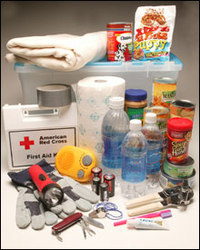Preparedness
If a disaster or an emergency should hit your area, it's important to make sure you are prepared. Here are some tips to follow in case you are faced with a worst case scenario.
• Discuss the type of hazards that could affect your family. Know your home's vulnerability to storm surge, flooding and wind.
• Locate a safe room or the safest areas in your home for each hurricane hazard. In certain circumstances the safest areas may not be your home but within your community.
• Determine escape routes from your home and places to meet. These should be measured in tens of miles rather than hundreds of miles.
• Have an out-of-state friend as a family contact, so all your family members have a single point of contact.
• Make a plan now for what to do with your pets if you need to evacuate.
• Post emergency telephone numbers by your phones and make sure your children know how and when to call 911.
• Check your insurance coverage - flood damage is not usually covered by homeowners insurance.
• Stock non-perishable emergency supplies and an Emergency Supply Kit.
• Use a NOAA Weather Radio. Remember to replace its battery every 6 months, as you do with your smoke detectors.
• Take First Aid, CPR and disaster preparedness classes.
____________________________________________________________________________
Emergency Supply Kit

Suggested Items -
Note: It's important to make sure the kit is ready to go and it contains enough supplies to last several days
Basic Emergency Supplies Kit
- Water, one gallon of water per person per day for at least three days, for drinking and sanitation
- Food, at least a three-day supply of non-perishable food
- Battery-powered or hand crank radio and a NOAA Weather Radio with tone alert and extra batteries for both
- Flashlight and extra batteries
- First aid kit
- Whistle to signal for help
- Dust mask to help filter contaminated air and plastic sheeting and duct tape to shelter-in-place
- Moist towelettes, garbage bags and plastic ties for personal sanitation
- Wrench or pliers to turn off utilities
- Manual can opener for food
- Local maps
- Cell phone with chargers, inverter or solar charger
Additional Emergency Supplies
- Prescription medications and glasses
- Pet food and extra water for your pet
- Cash or traveler's checks and change
- Important family documents such as copies of insurance policies, identification and bank account records in a waterproof, portable container
- Emergency reference material such as a first aid book
- Sleeping bag or warm blanket for each person
- Complete change of clothing including a long sleeved shirt, long pants and sturdy shoes
- Household chlorine bleach and medicine dropper - When diluted, nine parts water to one part bleach, bleach can be used as a disinfectant. Or in an emergency, you can use it to treat water by using 16 drops of regular household liquid bleach per gallon of water. Do not use scented, color safe or bleaches with added cleaners.
- Fire extinguisher
- Matches in a waterproof container
- Feminine supplies and personal hygiene items
- Mess kits, paper cups, plates, paper towels and plastic utensils
- Paper and pencil
- Books, games, puzzles or other activities for children
Supplies for Unique Needs
For Baby:
- Formula
- Diapers
- Bottles
- Powdered milk
- Medications
- Moist towelettes
- Diaper rash ointment
For Adults:
- Denture needs
- Contact lenses and supplies
- Extra eye glasses
